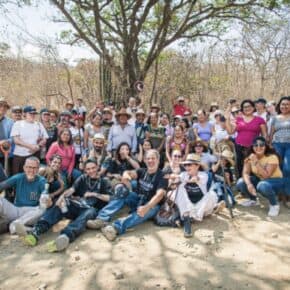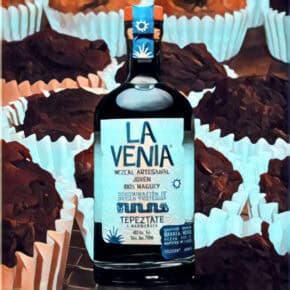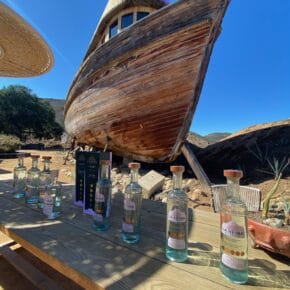In the world of bread baking and fermentation, a recently released academic study entitled “The diversity and function of sourdough starter microbiomes:” was a splash of ice cold water. It is a sacrosanct belief among bakers that geography plays a key role in creating unique qualities within bread, this is after all what’s at the base of all the hoopla over sourdough bread in San Francisco. And this all begins with the starter.
Starter culture
So just what is the starter, or mother as it is commonly called in the world of fermentation? In bread, it is a fermented mixture of flour and water, containing a colony of microorganisms/microbes/microbiomes including wild yeast and lactobacilli. The purpose of the starter is to produce a vigorous leaven and to develop the flavor of the bread. In practice there are several kinds of starters, as the ratio of water to flour in the starter varies. A starter may be a liquid batter or a stiff dough. And they are coveted and shared, not just in local communities, but across states, countries and continents. You can buy starters online and starters can be ancient, refreshed over the years. Look at balsamic vinegar, kombucha, and even mezcal. There is a reason why those seasoned fermentation tanks are cherished, they are full of incredible microbes and starters!
Side note, in case you are beginning to think I am being overwrought in talking about how coveted starters are, just read the novel “Sourdough” by Robin Sloan about protagonist Lois, whose life changes when the two brothers who run a neighborhood joint, bestow upon her “their culture, the sourdough starter used to bake their bread. She must keep it alive, they tell her – feed it daily, play it music, and learn to bake with it.”
Demolishing a long held belief
Researchers from across the country decided to engage in “a comprehensive study of how the microbial diversity of sourdough starters varies across and between continents. To investigate this, Landis, Oliverio et al. used genetic sequencing to characterize the microbial communities of sourdough starters from the homes of 500 bread bakers in North America, Europe and Australasia.”
And what did they conclude?
This research demonstrates which species of bacteria and yeast are most commonly found in sourdough starters, and suggests geographical location has little influence on the microbial diversity of these cultures. Instead, the diversity of microbes likely depends more on how the starter culture was made and how it is maintained over time.
Collective gasp
Given how much emphasis is given on the importance of terroir and geography in the world of wine, and mezcal, this conclusion was not easy for any to digest, in or outside the world of bread baking. We often talk about how the magic of mezcal making happens in fermentation, that there is so much variation based on geography and how that influences what is in the air, a key ingredient in open air fermentation. Could everything we thought possibly be wrong?
Reading through the research paper and how they catalogued and studied the starters from all angles is the scientific version of a police procedural. The devil is in the details and once you start looking under the hood of the conclusion it is much more nuanced than initially presented. For one, there is this buried down in the discussion, “The limited role of geography in explaining sourdough diversity may be driven by the widespread movement of starters across large geographic distances through starter sharing or commercial distribution. Flour, a major potential source of microbes in de novo starters (Minervini et al., 2015; Reese et al., 2020), is also moved across large spatial scales. This geographic homogenization of starter and flour microbes likely swamps out any regional differences in potential yeasts or bacteria that can disperse into starters.”
Mezcal is not bread, primarily in that people are not sharing agave fermentation starters across regions, though that could be an interesting research study, particularly in places like San Luis Potosi where they use pulque starters to get the fermentation process going. It seems for the time being we in the world of mezcal can continue extolling the geographic influence when it comes to the fermentation process, though god help the research team that might prove otherwise…












There are big differences between propagation and maintenance of a sourdough culture for baking bread and making Mezcal. The sourdough culture undergoes many passages before use and each one will tend to refine the culture for use as a bread leaven, while Mezcal is made without pitching a sterile culture and relies on whatever wild yeasts found on the agave pinas that survive the horno. Until a study of this type is performed on a fermenting batch of roasted agave pinas to sequence the bacteria and yeast involved, I would not bet that the microorganisms will be all the same from producer to producer and batch to batch.
I agree in that there a multitude of differences between agave spontaneous fermentation and sourdough starters. But the origin of the microbiome (combination of yeasts, bacteria and “others” [misquoting David Bowie in his celebrated Ladies, Gentlemen and Others]) in agave has little to do with what is able to survive the cook. Most of the things that are invited to the fermentation were not living “inside” the agave, but are just third party invitees that are lured by the sudden appearance of tasty nutritious sugars. Plenty of studies have been conducted around and about this, identifying some of these yeasts and bacterias, but nothing of the size and ambition of this sourdough paper has ever been performed in the agave world. Which is why I think this study is rather interesting and worth taking a careful look at.
Exactly! There is still so much to understand about microbiomes and I really appreciated the in depth approach to this study. I would love to see an approach like this in the agave world, though not with a similar conclusion. I can only handle so much dismantling of everything I thought I knew 🙂
Hmmm, coming from a open fermenting pino background, the wild yeast were from what was on the grapes-never heard of through the air. For mezcal it may be the same, depending on what if any microbes make it through the horno-cooking stage. Seems to this biologist that single airborne organisms would be at a competitive numerical disadvantage to those already there in larger numbers. Unsterilized wood vats would have a plethora of micro-organisms ready to go. I know some bacanora producers that maintain a stater microbe batch- one said flies were a good sign, so maybe airborne? And note that wild microorganisms arte not always a good thing-they can impart bad flavors also-ask any beermaker.